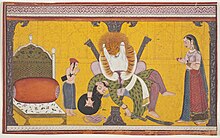Hiranyakashipu

Hiranyakashipu ( Sanskrit , हिरण्यकशिपु, hiraṇyakaśipu ) is a demon king ( asura ) in Hinduism , whose younger brother Hiranyaksha was killed by Varaha , an avatar of Vishnu .
Legend
Enraged by his brother's death, Hiranyakashipu decided to acquire magical powers by repenting for Brahma . Hiranyakashipu asked for a favor from Brahma in such a way that he could not die, neither on earth nor in space, nor in fire or water, neither day nor night, neither inside nor outside, neither by the hand of a person, of a god nor by an animal or any other living or inanimate being. Brahma was satisfied with his repentance and granted his request.
Hiranyakashipu's son Prahlada
Hiranyakashipu was a Daitya and hated the Devas , especially the supreme deity, Vishnu, whose followers he began to torment. Hiranyakashipu's son, Prahlada , was a very devoted follower of Vishnu. Hiranyakashipu failed to convince his son to follow him against Vishnu and therefore tried to kill him, but Prahlada was protected by Vishnu. When asked, Prahlada refused to recognize his father as the supreme lord of the universe (although he had used the favor of Brahma to subjugate the entire world), claiming that Vishnu was omnipresent . Hiranyakashipu tried several more times to kill his son.
Holi
One of the attempts was that Hiranyakashipu's demonic sister Holika sat on a burning pyre with Prahlada. Holika had a special gift that saved her from fire. Prahlada sang Vishnu's name and Holika was burned in the fight between good and evil, but nothing happened to Prahlada. The burning of Holika is still celebrated today in the Hindu Holi festival.
Narasimha
Hiranyakashipu asked if Vishnu was hidden in a certain pillar and Prahlada replied that it was. Hiranyakashipu smashed the pillar and Narasimha emerged from it. Narasimha killed Hiranyakashipu, for he was neither man nor beast nor a deva (but an avatar of Vishnu, who is also called Devadeva, god of gods; and he comes in a form that is half man and half lion), and he did so during twilight (neither by day nor by night), where he placed him on his knee (neither on earth nor in space) and on the threshold of the entrance to a courtyard (neither inside nor outside) and using his claw nails as weapons (neither animate nor lifeless).
symbolism
Demons (see also Andhaka , Hiranyaksha , Mahisasur ) endanger the existing order - wanted by gods and humans. They unite in themselves all evil, d. H. destructive, selfish and ultimately stupid forces. They question the peaceful coexistence of people, in which values such as wisdom as well as inner serenity and harmony should play a dominant role.
presentation
In classical Indian sculpture, demons are not found to be worthy of any individual representation - only the killing of Hiranyakashipu by Narasimha is shown. Narasimha's victory over Hiranyakashipu is dramatized in the dance theater forms Bhagavata mela in three villages around Thanjavur in Tamil Nadu and Prahlada nataka in Odisha .
literature
- Anneliese and Peter Keilhauer: The Imagery of Hinduism. The Indian world of gods and their symbolism. DuMont, Cologne 1986, ISBN 3-7701-1347-0 .
- Veronica Ions: Indian Mythology. Hamlyn Publishing, London 1988, ISBN 0-600-34285-9 .


